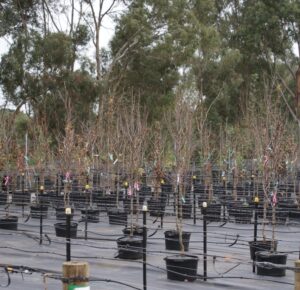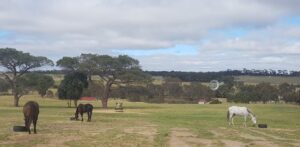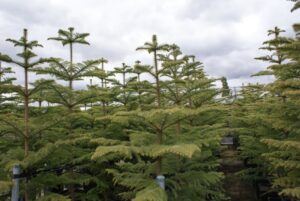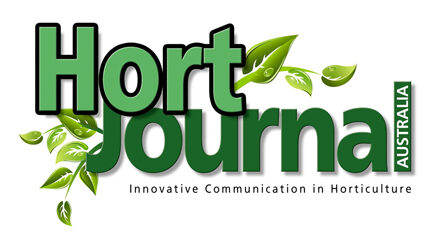
Victoria offers grants for farm trees
By John Fitzsimmons
The Victorian Government has announced the availability of grants to support the planting of trees on farms, promoting the potential benefits for farmers, the greenlife industry and the environment. This new grant program is broadly separated into two parts: one where the farmer or landowner implements the program, and a second where specialist planting and/or plantation management services are engaged by the farmer or landowner.
Victoria’s Trees on Farms Program
Victoria’s Trees on Farms Program provides grants up to $80,000 for landholders to plant trees, while the related Trees on Farms Incubator program provides grants up to $50,000 for tree planting service providers and forestry professionals.
The potential benefits of the program overall include:
- improved shade and shelter for livestock
- reduced erosion and enhanced water quality
- improved soil health
- enhanced biodiversity
- production of wood products for use on-farm or for sale (e.g., fence posts, firewood)
- carbon sequestration (lowering a farm’s net carbon emissions or generating carbon credits for sale to ‘heavy emitters’ seeking to offset their emissions)
Depending on the area planted, species selection and mix, and plantation management, landowners could utilise the grants to enhance tree planting for financial gain, environmental benefit, or a mix of both. There may be situations where broader community or landscape benefit could drive adoption.
For the greenlife sector the program has potential to increase propagation, production and revenue in existing markets, broaden and diversify production into suitable species to meet new demand, and initiate or strengthen engagement with rural landholders wishing to initiate or expand tree planting programs.
Of course, like many funding or support programs, the devil is in the detail. There are maximum areas that will be funded (project size). Grants are limited in dollars per hectare depending on whether, for example, a project is a productive timber lot or an environmental project.

Farm forestry plantings must be at least three hectares in size and be established in areas that receive at least 500 mm rainfall annually. Integrated environmental plantings must be at least five hectares in size and should be able to achieve carbon sequestration of at least five tonnes of CO2[GS1] e per hectare per year over 25 years. Both farm forestry plantings and integrated environmental plantings can be made across different blocks within the one project. The program is intended for projects up to 20 hectares. Projects above 20 hectares will be considered at the discretion of the Victorian Department of Agriculture.
While the program acknowledges the differing motivations of landowners, and is therefore flexible in its approach to species selection and spatial arrangement, the program guidelines state: ‘Farm forestry plantings for timber production (use) species which have known timber qualities, (and) integrated environmental plantings use a mix of native species consistent with the local Ecological Vegetation Class*[GS2] and provide co-benefits to the surrounding agricultural system.’
Eligibility
Applicants must be the freehold owner of the land within Victoria or be a land manager with formal approval from the owner. Presumably leaseholders are excluded. Successful applicants will receive grant funding in instalments provided upon completion of project milestones. Integrated environmental plantings are eligible to receive $2,000 per hectare (excl. GST) up to a total of $40,000 (excl. GST). Farm forestry plantings are eligible to receive up to $4,000 per hectare (excl. GST) up to a total of $80,000 (excl. GST).
Exclusions
Among several exclusions, grant money cannot be used for areas of land with existing native vegetation, land where there has been removal of native vegetation to support a Trees on Farms project, or land that has had native vegetation removed in the previous five years. Grant money cannot be used to cover any costs not directly associated with the project, including primary producer’s labour costs; however, these can be included as in-kind contributions.
Victoria’s Trees on Farms Program projects must be implementation-ready. Project plans must include details on design and planting preparation, appropriate species selection, as well logistical matters such as seedling ordering and purchasing. Project plans must also include a detailed project timeline and budget.
Implementation readiness can be demonstrated in one of four ways:
- engagement of a professional service provider to co-design or assist in developing your project plan (additional funding is available under the program to engage a service provider – see below)
- participation in the Trees on Farms Incubator Program (below)
- provision of evidence of relevant experience, training, or having previously completed similarly scaled tree-growing activities
- provision of evidence of a previously developed farm master plan, an on-farm emissions reduction action plan, or similar tree establishment plan that provides suitable information and detail
Trees on Farms Incubator program
An additional grants program, the Trees on Farms Incubator program, offers planting service providers and forestry professionals up to $50,000 to support landowners who might be contemplating planting trees on their property. This service will help landowners develop tailored, implementation-ready project plans to align with their property and planting goals, while providing education, training and upskilling for tree planting and management activities.

An Incubator Project is a customised suite of activities designed to develop the practical, technical, and strategic capacity of landowners to assist them to make decisions about establishing and managing trees on their farms. Incubator projects can be delivered over a period of up to 12 months. Examples of activities that can be delivered by an Incubator Project include:
- coordination activities: landowner network meetings or on-site visits
- education activities: visits to demonstration sites or timber mills and processors, or delivery of tree growing courses
- planning activities: feasibility assessments, financial modelling, development of Victorian Trees on Farms project plans
Once they have completed the Incubator Project, landowners will be supported to develop their own Trees on Farms project plan that is implementation-ready and that can be used to apply for grant funding under the Victorian Trees on Farms Program.
Eligibility
The Incubator Program seeks applications from expert facilitators or industry professionals; it is not intended for individual landowners to apply. Landowners wishing to participate in an Incubator Project are encouraged to mobilise neighbours or networks to create their project. They will need to identify a professional facilitator to apply on their behalf. This could be a local Landcare facilitator, a professional consultant or other such expert.
Professional facilitators, trainers, consultants with expertise in forestry, land management, agriculture or related fields can apply for the Incubator Program. To be eligible for funding, applicants must:
- demonstrate experience or expertise in forestry, tree planting projects or land management coordination / facilitation
- identify a cohort of landowners (more than two individuals) based in Victoria within a common region or locality to participate in their incubator project
- commit to producing a project plan for each participating landowner
- meet the department’s due diligence requirements
- hold the relevant policies of insurance (at least $20 million public liability cover, at least $5 million per occurrence for professional indemnity risks, WorkCover insurance as applicable)
Funding can be used for resources, materials, the engagement of technical experts, and staffing required to undertake eligible coordination, education, and planning activities and to develop Trees on Farms project plans.
Exclusions
Grant money cannot be used for promotional activities seeking participants for the incubator project, advertising or promotional activities, site preparation, seedlings, or other activities related to tree establishment, tree establishment or management activities, construction or repairs to infrastructure, public liability insurance, social media or fundraisers.
The Victorian Trees on Farms Program comes at a time when parts of the state are facing challenging seasonal conditions while some farming sectors are also facing challenging cost of production pressures. The impact of the state’s impending Emergency Services levy on landholders could also affect uptake.
Further information
Round 1 of the Victorian Trees on Farms Program is open until 30 June 2026.
For more information, please visit the Agriculture Victoria website: www.agriculture.vic.gov.au and search for:
- ‘Trees on farms’
- ‘Victorian Trees on Farms Program’
- ‘Trees on Farms Incubator program’
* To find the Ecological Vegetation Class (EVC) benchmark for your area, visit: https://www.environment.vic.gov.au/biodiversity/bioregions-and-evc-benchmarks
